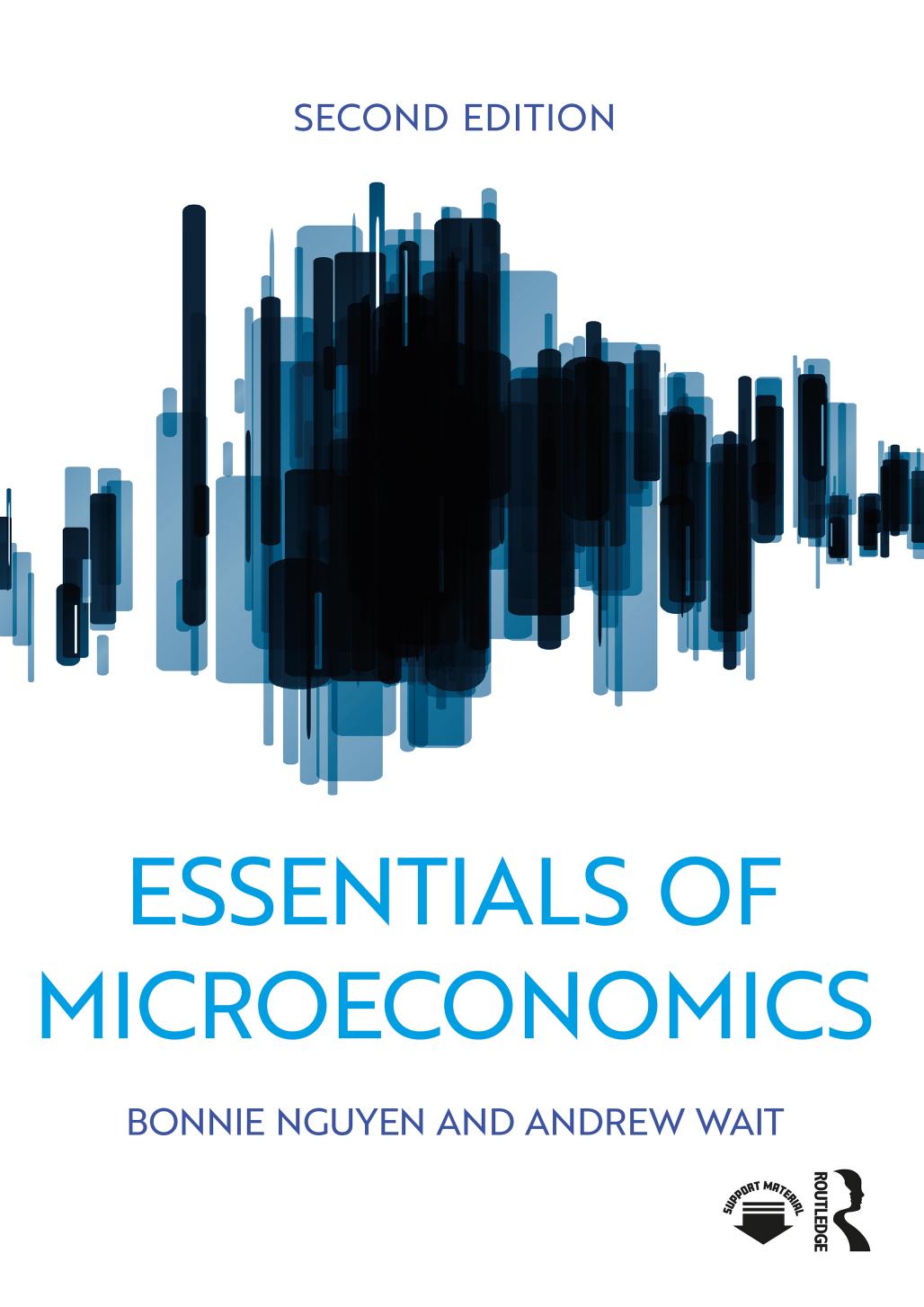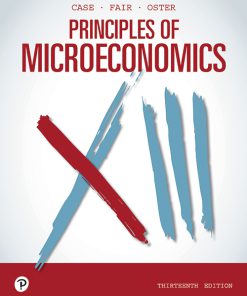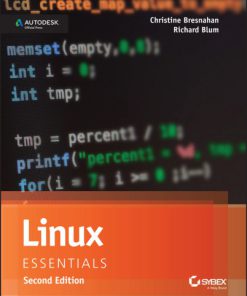Essentials of Microeconomics 2nd Edition by Bonnie Nguyen, Andrew Wait 1032453672 9781032453675
$50.00 Original price was: $50.00.$25.00Current price is: $25.00.
Essentials of Microeconomics 2nd Edition by Bonnie Nguyen, Andrew Wait – Ebook PDF Instant Download/DeliveryISBN: 1032453672, 9781032453675
Full download Essentials of Microeconomics 2nd Edition after payment.

Product details:
ISBN-10 : 1032453672
ISBN-13 : 9781032453675
Author: Bonnie Nguyen, Andrew Wait
This eBook+ version includes the following enhancements: Quizzes at the end of each chapter to help students consolidate their understanding of the topic Interactive Multiple Choice Questions where students can choose an option and the answer will be revealed Interactive Open-Ended Questions where students can type out their responses and compare it with model answers Discussion Questions where students are encouraged to apply theories to real world scenarios Essentials of Microeconomics is an excellent introduction to microeconomics. It presents the basic tools of microeconomics clearly and concisely. It presents a vigorous treatment of all relevant introductory microeconomic concepts, and emphasizes on modern economics — game theory and imperfect markets. Each chapter is self-contained and includes the required key mathematical skills at the start. Now in its second edition, this updated textbook includes: Expanded lecturer resources, including concise lecture slides, sample exam questions and test bank MCQs An additional section on Policy and Applications This book is ideal not only for introductory microeconomics course, but its level of analysis also makes the book appropriate for introductory level economics taught at postgraduate level. With the emphasis on strategy, this text is also well suited for use in business economics courses.
Essentials of Microeconomics 2nd Table of contents:
Part I Key concepts and tools
Chapter 1 Key economic concepts
1.1 Introduction
1.2 Scarcity and opportunity cost
1.3 Marginal analysis
1.4 Ceteris paribus
1.5 Correlation and causation
1.6 Concluding comments
Notes
Questions & answers
Chapter 2 Key mathematical tools
2.1 Introduction
2.2 Equations
2.2.1 Straight lines
2.2.2 The slope of a straight line
2.2.3 Determining the equation of a straight line
2.2.4 Curves
2.3 Differentiation
2.3.1 A simple rule for differentiation
2.3.2 Finding minima and maxima
2.4 Elasticity
2.5 Simultaneous equations
2.6 Concluding comments
Notes
Questions & answers
Chapter 3 Key strategic tools
3.1 Introduction
3.2 The essentials of game theory
3.3 Simultaneous-move games
3.3.1 Representing simultaneous-move games: the normal form
3.3.2 Solving simultaneous-move games
3.4 Some types of simultaneous-move games
3.4.1 Prisoner’s dilemma
3.4.2 Coordination game
3.5 Sequential games
3.5.1 Representing sequential games: the extensive form
3.5.2 Solving sequential games
3.6 Concluding comments
Notes
Questions & answers
Part II Gains from trade
Chapter 4 Trade and the PPF
4.1 Introduction
4.2 Gains from exchange
4.3 Gains from specialisation
4.3.1 The production possibility frontier (PPF)
4.3.2 Absolute advantage and comparative advantage
4.3.3 Specialisation
4.4 Concluding comments
Notes
Questions & answers
Chapter 5 Bargaining
5.1 Introduction
5.2 Bargaining and surplus
5.3 Take-it-or-leave-it negotiations
5.4 Multiple-offer bargaining
5.5 Some caveats
5.6 Concluding comments
Notes
Questions & answers
Part III Market fundamentals
Chapter 6 Demand
6.1 Introduction
6.2 Benefit and willingness to pay
6.3 Individual demand
6.4 Market demand
6.5 Concluding comments
Notes
Questions & answers
Chapter 7 Production and costs
7.1 Introduction
7.2 The short run and long run
7.3 Production
7.3.1 Marginal product
7.3.2 Returns to scale
7.4 Short-run costs
7.4.1 Fixed and variable costs
7.4.2 Marginal cost
7.4.3 Average costs
7.5 Long-run costs
7.5.1 Long-run marginal cost
7.5.2 Long-run average cost
7.5.3 A final note
7.6 Total revenue, total cost and economic profit
7.7 Concluding comments
Notes
Questions & answers
Chapter 8 Supply
8.1 Introduction
8.2 Firm supply
8.3 Market supply
8.4 Concluding comments
Questions & answers
Chapter 9 Equilibrium and welfare
9.1 Introduction
9.2 Market equilibrium
9.3 Comparative static analysis
9.4 Welfare
9.4.1 Consumer surplus
9.4.2 Producer surplus
9.4.3 Total surplus
9.5 Pareto efficiency
9.6 Concluding comments
Notes
Questions & answers
Chapter 10 Elasticity
10.1 Introduction
10.2 Measuring elasticity
10.2.1 Point method
10.2.2 Midpoint (or arc) method
10.3 Applications
10.3.1 Elasticity of demand
10.3.2 Elasticity of supply
10.3.3 Cross-price elasticity
10.3.4 Income elasticity
10.4 Concluding comments
Notes
Questions & answers
Part IV Types of markets
Chapter 11 Introduction to markets
11.1 Introduction to the four types of markets
Chapter 12 Perfect competition
12.1 Introduction
12.2 Characteristics of perfect competition
12.3 Supply in the short run
12.3.1 Firm supply in the short run: the shut-down decision
12.3.2 Market supply in the short run
12.3.3 Profits and losses
12.4 Supply in the long run
12.4.1 Firm supply: the exit/entry decision
12.4.2 Elimination of profits and losses
12.5 Market supply in the long run
12.6 Concluding comments
Notes
Questions & answers
Chapter 13 Monopoly
13.1 Introduction
13.2 Characteristics of a monopoly
13.3 The single-price monopolist
13.3.1 Marginal revenue
13.3.2 Profit maximisation
13.4 Welfare under the single-price monopolist
13.4.1 Consumer and producer surplus
13.4.2 Total surplus and deadweight loss
13.5 Price discrimination
13.5.1 First-degree price discrimination
13.5.2 Third-degree price discrimination
13.5.3 Second-degree price discrimination
13.5.4 Further comments about price discrimination
13.6 Natural monopoly
13.7 Regulating a natural monopoly
13.7.1 Government ownership
13.7.2 Marginal-cost price regulation
13.7.3 Average-cost price regulation
13.7.4 Hidden information
13.8 Concluding comments
Notes
Questions & answers
Chapter 14 Monopolistic competition
14.1 Introduction
14.2 Characteristics of monopolistic competition
14.3 The short run
14.4 The long run
14.4.1 Effects of entry and exit on demand curves
14.4.2 Elimination of profits and losses
14.5 Welfare under monopolistic competition
14.6 Concluding comments
Notes
Questions & answers
Chapter 15 Oligopoly
15.1 Introduction
15.2 Characteristics of an oligopoly
15.3 Simultaneous-move games
15.3.1 Price wars: an example of a prisoner’s dilemma
15.3.2 Can firms avoid the prisoners’ dilemma?
15.4 Product choice: an application of a coordination game
15.4.1 Can firms avoid coordination failure?
15.5 Sequential games
15.5.1 Credible threats
15.5.2 First-mover advantage
15.5.3 A second-mover advantage
15.6 Concluding comments
Notes
Questions & answers
PART V Market failures
Chapter 16 Price regulation, taxes and subsidies
16.1 Introduction
16.2 Price regulation
16.2.1 Price floor
16.2.2 Price ceiling
16.2.3 Price controls in the long run
16.3 Taxes and subsidies
16.3.1 Taxes
16.3.2 Further analysis
16.3.3 Subsidies
16.4 Concluding comments
Questions & answers
Chapter 17 Externalities
17.1 Introduction
17.2 External costs and benefits
17.2.1 Positive consumption externalities
17.2.2 Negative production externalities
17.3 The problem with externalities
17.3.1 Positive consumption externalities
17.3.2 Negative production externalities
17.3.3 Positive production and negative consumption externalities
17.4 Solutions to externalities
17.4.1 Private-market solutions: the Coase Theorem
17.5 Government solutions to externalities
17.5.1 Taxes and subsidies
17.5.2 Quantity regulation
17.5.3 Taxes and subsidies versus quantity regulation
17.5.4 Tradeable permits
17.6 Concluding comments
Notes
Questions & answers
Chapter 18 Public goods and common resources
18.1 Introduction
18.2 Public goods
18.2.1 The marginal benefit curve for a public good
18.2.2 The problem with public goods
18.3 Common resources and the Tragedy of the Commons
18.4 Concluding comments
Notes
Questions & answers
PART VI International trade
Chapter 19 International trade
19.1 Introduction
19.2 The welfare effects of international trade
19.2.1 Welfare under autarky
19.2.2 Welfare with international trade
19.3 Barriers to trade
19.3.1 Tariffs
19.3.2 Quotas
19.3.3 Tariffs vs. quotas
19.4 Arguments against free trade
19.5 Concluding comments
Notes
Questions & answers
PART VII Economics in practice
Chapter 20 Some other markets
20.1 Introduction
20.2 The housing market
20.2.1 Demand for housing
20.2.2 Supply of housing
20.2.3 Housing auctions
20.3 The labour market
20.3.1 Supply of labour
20.3.2 Demand for labour
20.3.3 Equilibrium and market predictions
20.3.4 Complications
20.4 The capital market
20.4.1 Supply of capital
20.4.2 Demand for capital
20.4.3 Equilibrium and market predictions
20.4.4 Complications
20.5 Concluding comments
Questions & answers
Chapter 21 Economic policy
21.1 Introduction
21.2 Economic policy in practice: some examples
21.2.1 Lowering transaction costs
21.2.2 Managing common resources
21.2.3 Competition policy
21.3 The Theory of Second Best
21.4 The policy cycle
21.5 Concluding comments
Questions & answers
Chapter 22 Economics and evidence
22.1 Introduction
22.2 Econometrics and statistics
22.3 Experimental economics
22.4 Behavioural economics
22.5 Concluding comments
People also search for Essentials of Microeconomics 2nd:
essentials of microeconomics pdf
essentials of microeconomics bonnie nguyen pdf
essentials of microeconomics bonnie nguyen
essentials of microeconomics pearson
essentials of microeconomics 2nd edition pdf
Tags: Essentials, Microeconomics, Bonnie Nguyen, Andrew Wait
You may also like…
Business & Economics
Business & Economics - Economics
Medicine - Anatomy and physiology
Essentials of Anatomy & Physiology, 2nd Edition Kenneth S. Saladin
Engineering - Chemical Engineering
Business & Economics - Econometrics
Essentials of Microeconomics 2nd Edition Bonnie Nguyen Andrew Wait
Business & Economics - Professional Finance
Business & Economics
Business & Economics
Microeconomics 10th Edition by David C Colander ISBN 1259655504 978-1259655500
Computers - Operating Systems












